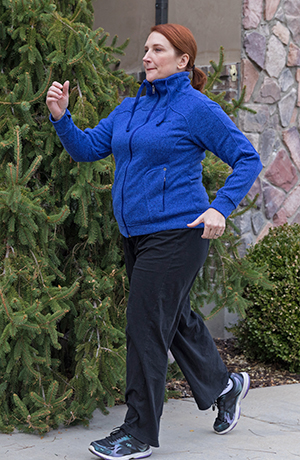Lifestyle Changes to Control Cholesterol
You can control your cholesterol through diet, exercise, weight management, quitting smoking, and stress management as directed by your healthcare provider. These things can also lower your risk for heart and vascular disease.

Eating healthy
Adopt a heart-healthy diet. Your healthcare provider will give you information on diet changes you may need to make. Your provider may recommend that you see a registered dietitian who can guide you about the appropriate portion sizes, total calorie recommendations, and realistic ways to change bad eating habits. Changes may include:
-
Cutting back on the amount of fat and cholesterol in your meals
-
Eating less salt (sodium). This is especially important if you also have high blood pressure. Don’t add salt to your food at the table. Season foods with herbs instead of salt when you cook.
-
Eating more fresh vegetables and fruits
-
Eating lean proteins, such as fish, poultry, beans, legumes (beans and lentils), and peas. Eat fish, and poultry without the skin.
-
Eat about 2 servings of fish each week. Good choices include salmon, herring, tuna, sardines, or mackerel. The fish should not be fried. Most fish contain omega-3 fatty acids. These help lower total blood cholesterol.
-
Eating less red meat and processed meats
-
Adding soluble fiber, plant stanols, and sterols to your daily meals. They block the absorption of cholesterol from the digestive tract, which helps to lower LDL cholesterol.
-
soluble fiber is found in fruits, beans, and oats)
-
plant stanols and sterols are found in whole grains, nuts, legumes, and oils, like olive and avocado oil
-
Using skimmed milk, and low-fat dairy products
-
Using vegetable and nut oils in limited amounts. Use nontropical vegetable oils like (Canola, Corn, Olive, Peanut, Safflower, Soybean, and Sunflower) instead of solid fats.
-
Limiting how many canned, dried, packaged, and fast foods, sweets and processed foods, like chips, cookies, and baked goods, that you eat
-
Limiting how many sugar-sweetened beverages you drink
-
Limiting how often you eat out
-
Limiting alcohol
-
If you are pregnant or planning to be pregnant, or are breastfeeding, talk with your healthcare provider about the best fish choices and how much is safe to eat.
Getting exercise
Regular exercise is a good way to help your body control cholesterol. Regular exercise can help in many ways.
-
Give more oxygen to your muscles and tissues
-
Help you manage your weight
-
Help your heart pump better
-
Lower your blood pressure
-
Reduce stress and anxiety
-
Additionally, it can reduce your risk of developing diabetes or, if already present, lessen the need for insulin.
Your healthcare provider may recommend that you get more physical activity if you haven't been active. Experts recommend at least 2 ½ hours of moderate intensity exercise each week for substantial health benefits. Your provider may recommend that you get moderate to vigorous physical activity for at least 40 minutes each day. You should do this for at least 3 to 4 days each week. If you can't do the full 40 minutes, doing moderate to vigorous activity in a shorter amount of time is better for your cholesterol than not doing any. Start at a level where you feel comfortable. Increase your time and pace a little each week. A few examples of moderate to vigorous activity are:
-
Walking at a brisk pace. This is about 3 to 4 miles per hour.
-
Jogging or running
-
Swimming or water aerobics
-
Hiking
-
Dancing
-
Martial arts
-
Tennis
-
Riding a bicycle or stationary bike
-
Dancing
Managing your weight
If you are overweight or obese, your healthcare provider will work with you to help you lose weight and lower your BMI (body mass index). Making diet changes and getting more physical activity can help. Changing your diet will help you lose weight more easily than adding exercise.
Quitting smoking
Smoking, vaping, and other tobacco use can raise cholesterol and make it harder to control. Quitting is tough. But millions of people have given up tobacco for good. You can quit, too! Think about some of the reasons below to quit smoking. Do any of them make you think twice about your smoking habit?
Stop smoking because it:
-
Keeps your cholesterol high, even if you make all the other changes you’re supposed to
-
Damages your body. It especially harms your heart, lungs, skin, and blood vessels.
-
Makes you more likely to have a heart attack (acute myocardial infarction), stroke, or cancer
-
Stains your teeth
-
Makes your skin, clothes, and breath smell bad
-
Costs a lot of money
Ask your healthcare provider for medicines or nicotine replacement products to help you quit.
Controlling stress
Learn ways to control stress. Practice relaxation techniques like meditation, progressive muscle relaxation, and biofeedback. This will help you deal with stress in your home and work life. Controlling stress can greatly lower your risk of getting cardiovascular disease.
Get your Cholesterol levels tested regularly :
High blood cholesterol doesn’t have symptoms, which is why getting your cholesterol levels checked is so important. Talk with your healthcare team about your health history and how often you need to have your cholesterol checked.